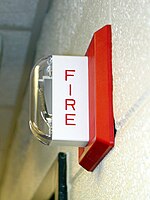
Photo from wikipedia
This paper presents some fundamental factors that influence the reliability of fire and gas (F&G) alarm systems by incorporating human factor's principles. As compared, standard alarm and the safety‐related alarm… Click to show full abstract
This paper presents some fundamental factors that influence the reliability of fire and gas (F&G) alarm systems by incorporating human factor's principles. As compared, standard alarm and the safety‐related alarm will show two different values of IPF given in process hazard analysis (PHA) studies. In this study, fault tree diagram has been used to calculate the process flow diagram (PFD) value, to identify which alarm type could meet the standard of safety integrity level (SIL1) for F&G system for a single train process. Comparison of both alarms is done for three types of selected detectors; flammable gas detectors, flame detectors, and toxic gas detectors. It has been identified that standard alarm for all type of detectors does not meet the SIL1 requirement. Compared to safety‐related alarm, all detectors are able to meet the requirement of SIL1. Since the greater IPF will be given for safety‐related alarm, it is crucial to study the holistic factor that could maintain the system with good efficiency and performance. The human factor has been identified as the most critical element for safety‐related alarm. A complete coordinated approach is needed to ensure the performance and efficiency of the F&G alarm system can be maintained while process plants are able to be safely operated within as low as reasonably achievable region.
Journal Title: Process Safety Progress
Year Published: 2019
Link to full text (if available)
Share on Social Media: Sign Up to like & get
recommendations!